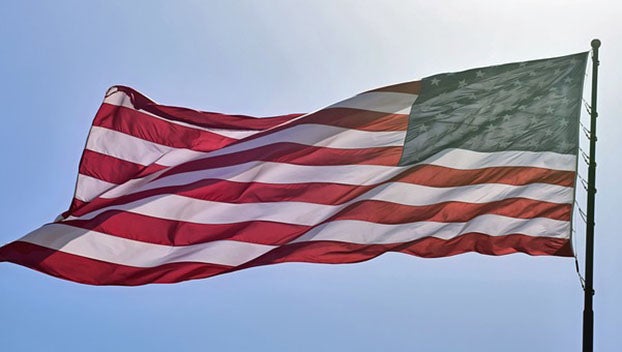Flag ordinance amended, sent back to Prince Edward supervisors
Published 1:32 am Wednesday, July 19, 2023
|
Getting your Trinity Audio player ready...
|
FARMVILLE – Prince Edward’s flag ordinance is going back to the board of supervisors for another vote. This version is slightly different from the one the county put in place last month, with fewer restrictions. The Prince Edward County Planning Commission made a couple changes during their meeting on Tuesday, July 18.
County rules limited the group to what they could or couldn’t recommend, however. Currently, there’s an emergency ordinance in place, limiting residents to a maximum of three flags on each parcel of land they own, no more than 120 square feet combined. But emergency ordinances can’t last forever. Within 60 days of the original vote, the planning commission has to hold a public hearing and determine if they approve of the emergency ordinance or if it needs more work. In a case like this, the commission can take away restrictions, but it can’t add any new requirements.
With that in mind, after more than an hour and a half of public hearings and discussion, the group made some changes Tuesday.
What does the new proposal say?
The new proposed flag ordinance, which was recommended by a unanimous vote Tuesday, gives some more leeway. Yes, there still is a limit of no more than three flags per parcel of land. And yes, the flags are limited to a total of 120 square feet. But the board added some exemptions.
First, if adopted, there would be no limit to the number of temporary flags allowed at a cemetery. They would all just have to be 1 square foot or less. Commission member Rhett Weiss had pointed out during the night’s discussion that nowhere in the county’s emergency ordinance did it mention cemeteries. He and other commission members agreed that it made no sense to restrict how many flags could be placed around the graves.
“It’s something that needs to be addressed,” Commission Chairman John Prengaman agreed. “Anywhere where there are standing multiple flags to recognize individuals, that needs to be addressed.”
Weiss also pointed out some inconsistencies with current law. Under the current county law, flag poles can be no higher than 20 feet. However, a resident can apply for a special use permit, to build a pole larger than 20 feet.
“If we’re gonna allow changes in the flag pole height, if there’s that ability, there should be the matching ability to change the flag size,” Weiss said. That way, he added, if someone wants to fly a flag larger than the 120 square feet maximum, they could apply for a permit to do just that. “I think it would take a lot of pressure off this issue. This is a way to compromise, by having a special use permit ability, having the ability to seek one if you want a flag bigger than 120 (square feet).”
The rest of the commission agreed, so in the proposal going back to supervisors, a resident would have the ability to request a special use permit to increase both the flag pole and flag size beyond current limits.
Why is the flag ordinance an issue?
Residents who spoke at Tuesday’s public hearing said they couldn’t understand why suddenly this was an issue.
“I haven’t found any proof of why we’re doing this,” said Rice resident Rex Williams. “Is it hurting anything? Is it hurting anybody? [Is] it a safety reason? If you had complaints, who are they? If it’s been working good for 160, 170 years, why change it?”
Walter Edwards, meanwhile, pointed out the multiple holes in the county’s current plan.
“You’re telling me it’s ok to have three flags,” Edwards said. “At the end of my driveway, there’s a flag. There’s a flag in my barn. My daughter brings home a college flag and puts it up. Come Christmas time, my wife puts a snowman flag up.”
That doesn’t count the times during football games, Edwards said, when he occasionally puts up his dad’s old Virginia Tech flag. But if his family just keeps doing what they’ve always done, now suddenly that means a fine from the county.
“You’re telling me I’ve got to take one of my flags down,” Edwards said. “I’ve got to take one off my barn or my daughter can’t put her college flag up. I bought this land. I pay for this land, I pay taxes on this land. This gives me the right to do what I want, as long as I’m not stroking out against somebody.Government needs to step back, leave people alone. Let us live our lives the way we’ve been living them. We’re not hurting anyone.”
He also cautioned county officials. If they did this because a flag offended someone, what happens when another symbol offends the wrong person? He pointed to crosses displayed at local churches and in people’s yards. Edwards wondered how long it would be before the sight of the cross offends someone.
Earl Wallace is the pastor over at Pisgah Baptist Church in Rice. He agreed with Edwards, asking why this suddenly became a problem.
“What is so offensive about this flag?” Wallace asked. “Why is it the American flag is suddenly offensive to this county? Just leave it alone. Why can’t folks just leave it alone?”
No content restrictions allowed
One of the questions that continues to come up involves a flag’s content. Why, residents ask, can’t the county simply put an exemption in place for all American flags? For that, you can thank a U.S. Supreme Court ruling in 2015 labeled Reed vs. Town of Gilbert.
The town of Gilbert, Arizona had specific restrictions for all temporary event signs. They could be no bigger than six square feet and could only be up for 12 hours before the event happened. Permanent signs from local companies, however, could announce anything at any time with no penalty. Pastor Clyde Reed of the Good News Community Church tried to put up one of these temporary signs, letting people know where and when worship service would be that week. Since the church didn’t own a building, the congregation met at a rotating number of schools and other locations. Each time, he would put up his signs a few days before service. And each time, the town cited him for violating the sign code.
So Reed sued the town and lost in federal district court, then again in the Ninth Circuit Court of Appeals. But the Supreme Court ruled in his favor, with justices stating the ordinance was unconstitutional because it focused on the content of the sign. Writing for the majority opinion, Justice Clarence Thomas argued that the law treated temporary and permanent signs differently because of content and that was illegal. That’s why Prince Edward County officials don’t try to write an ordinance targeting only certain flags or excluding others. They’re concerned it would lead to a lawsuit.
“The county can only regulate the size of flags, but not the content,” said Prince Edward County Planning Administrator Robert Love. “It cannot exempt any particular flag, regardless of what it may signify. To do so has been seen by the courts as a violation of constitutional rights and the first amendment.”
What happens next for flag ordinance?
Now the revised flag ordinance goes back to the Prince Edward County Board of Supervisors. Their next scheduled meeting is Tuesday, Aug. 8, which is when they could hold a public hearing and possibly take a vote.




